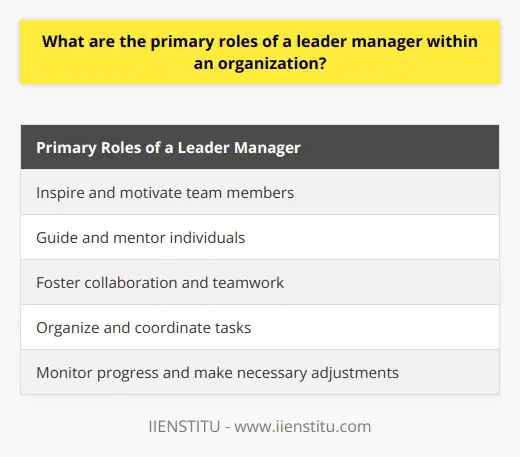
In today's fast-paced corporate world, leadership and management are commonly tossed around. Although they're often used in the same breath, they mean different things. But how do they diverge, and where do they overlap? The roles of a leader and a manager are far more nuanced than they may seem at first glance.
In this piece, we'll deep-dive into leadership and management. We'll examine each role's unique features, highlight their differences, and see how they work in a successful company. We'll also take a look at some examples of transactional leaders, compare transformational versus transactional leaders, and discuss various management styles.
By the time we're done, you'll fully understand the top 10 differences between managers and leaders. So, prepare as we travel through the intricate landscape of leadership versus management.
Understanding Leadership and Management: What's The Difference?

First off, we need to understand what leadership and management mean. Even though these two words are used interchangeably, they have different roles within an organization's structure.
Leadership is about inspiring and influencing people to work towards a common goal. A leader inspires change, encourages creativity, and prepares a roadmap for future growth. Leaders set the overall direction and help their team imagine how to reach that goal. They're trailblazers, guiding their teams through challenges and towards success.
Conversely, management revolves around implementing set processes and strategies to reach the organization's goals. Managers plan, sort, coordinate, and control resources - people and materials. The day-to-day running and efficient use of resources, tracking progress, and making necessary adjustments are handled by managers.
So, the central leadership vs. management difference boils down to their focus:
The Most Important Key to Leadership Success: Emotional Energy Management
Unlocking Niches: Divisional Structure for Successful Corporations
Building Strategic Relationships Making a Smooth Executive Transition
Leaders' lead' and inspire people to buy into their vision. Managers' manage' and coordinate tasks, ensuring that plans are effectively and efficiently carried out.
With each role being essential for an organization's success.
Making Sense of the Terms: Leader and Manager

We must define two key roles to understand leadership and management more clearly. A 'leader' inspires passion and inspires others towards a common goal. Leaders create change, spur growth, and foster a culture of teamwork and innovation. They can be found at any level of an organization, leading by example and encouraging others with their vision and values.
Conversely, a 'manager' symbolizes structure, control, and organization. Managers are in charge of implementing strategies, overseeing processes, and ensuring tasks are completed to meet goals. They're responsible for making sure the business operates with efficiency and productivity.
So, the leader and manager difference can be seen as the gap between inspiration and implementation. While leaders inspire and foster change, managers seek to implement techniques and maintain stability. Keep in mind, no role is above the other; both leaders and managers are vital to a company's success.
The Distinction Between a Leader and a Manager: Comparing and Providing Examples
We need to look at real-world examples to understand the difference between a leader and a manager truly.
When we think of visionary leadership, Steve Jobs, the co-founder of Apple Inc., comes to mind. Jobs, known for dreaming big and inspiring innovation, didn't get involved in regular tasks or detailed planning. Instead, he painted a bigger picture, packaged it with passion, and then inspired his team to chase after it. His leadership transformed our relationship with technology, and his influence is still felt in today's tech industry.
On the other hand, Tim Cook, who became CEO after Jobs, is an excellent example of effective management. His role involved overseeing the daily operations, tweaking processes, and ensuring Apple's strategic plans were efficiently executed. Apple grew into a trillion-dollar company under Cook's keen eye for details.
These examples show the concrete leader and manager difference. Steve Jobs inspired and set goals as a leader, while Tim Cook focused on strategic planning and efficiency as a manager.
But in real life, the lines often blur. Many successful individuals are visionary leaders and efficient managers, simultaneously inspiring their teams while managing resources and processes effectively. This underlines the reality that leadership and management are separate roles but interconnected and vital to an organization's success.
To illustrate the application of leadership and management skills across different industries, let's consider the healthcare sector. Healthcare leaders like a Chief Medical Officer inspire their teams to focus on patient care and innovation. Managers in this context, like a hospital administrator, ensure effective deployment of resources, manage staff schedules and ensure regulatory compliance.
To develop both leadership and management skills, individuals should focus on developing a range of soft and technical skills. Effective communication, emotional intelligence, and visioning are crucial for strong leadership. On the other hand, strategic planning, project management, and resource allocation are key management skills. Mentorship or coaching, self-reflection, and continuous learning through professional development courses can facilitate these skills' growth.
Leadership and Management in Practice: Roles and Functions
In practical business scenarios, leadership and management roles play out in distinct ways.
Think of a company as a ship. The leader is the captain, deciding the ship's destination and rallying the crew. They think of the bigger picture and inspire others to join the journey.
One example is when a CEO creates a new vision for the company. This could involve entering new markets or introducing new products.
In contrast, a manager is like a ship's engineer. They ensure everything runs swiftly, from the engines to the navigation systems. They manage the details, ensuring that plans are followed, and everything is controlled.
A project manager may create a detailed action plan for launching a new product. This plan outlines the tasks, responsibilities, deadlines, and methods involved.
While these roles are different, they're equally important. A ship can only reach its destination with a captain and an engineer. In the same way, a company needs both leaders and managers to be successful. Leaders inspire and guide, and managers keep the gears turning.
When these two roles work in tandem, they can propel a company to new heights of success.
However, leading and managing aren't always black and white. Some people can wear both hats, simultaneously taking on the roles of a leader and manager. In smaller businesses, for example, the same person might need to set the company's direction and oversee daily operations.
The goal isn't about being a leader or a manager but knowing when to lead and when to manage. The trick to mastering business lies in striking a balance between the two.
The Top 10 Differences Between A Manager and A Leader
Now that we understand what leadership and management involve let's explore the top 10 differences between managers and leaders. These differences will help us understand each role better and how they impact an organization.
Vision vs. Execution: Leaders build and share a compelling vision. Managers focus on executing strategies to realize that vision.
Change vs. Stability: Leaders seek to disrupt the status quo for better results. Managers aim for stability and efficiency.
Inspiration vs. Organization: Leaders motivate their team towards a common goal. Managers organize and coordinate tasks to achieve these goals.
Risk-taking vs. Risk Averseness: Leaders are more open to taking risks to foster innovation and growth. Managers aim to minimize risk to ensure smooth operations.
People vs. Process: Leaders focus on people, relationships, and skill development. Managers concentrate on processes and efficiency.
Long-Term vs. Short-Term: Leaders are often focused on long-term strategic thinking. Managers deal with short-term goals and urgent tasks.
Empowerment vs. Directing: Leaders empower their team members, fostering a sense of ownership. Managers direct and control, outlining individual tasks' performance.
Big Picture vs. Details Orientation: Leaders focus on the overall strategy and the bigger picture. Managers are detail-oriented and zero in on operational matters.
Innovation vs. Status Quo: Leaders encourage new ideas and innovation. Managers maintain the status quo to meet current objectives.
Divisional Structure Benefits And Challenges For Corporations
Key Functions Of Human Resource Management For Business Success
Influence vs. Authority: Leaders lead by influencing and inspiring. Managers rely more on their formal authority and control.
These points don't put leaders and managers against each other. Instead, they highlight the different strengths both roles bring to an organization. Organizations are at their best when leaders' visionary drive and managers' practical expertise work in perfect harmony.
Leaders and management are two sides of the same coin, each valuable and essential.
The key is to balance inspiring leadership visions with managerial efficiency. This creates a culture where innovation and operations are closely linked.
Influences of Leadership and Management in Business: Threading the Needle
To better understand leadership vs. management, it is important to grasp their distinct roles in the business landscape. As we delve deeper into this topic, we can gain a clearer understanding of how these roles differ from each other.
Leaders often lean towards a transformational approach. They create an exciting vision for the future, challenging their team to push beyond their comfort zone and reach new heights. Leaders are agents of change who seek to break old habits and make way for innovative solutions.
In contrast, managers often use a transactional style. These managers set clear expectations, explain the rewards for meeting them, and emphasize the consequences of not doing so. An example of a transactional leader could be a department head who sets team goals and applies strict rewards and penalties.
So how does transformational compare with transactional leadership? Transformational leaders aim to motivate their teams to work beyond their interests for the greater good of the group or organization. They inspire their teams to push harder than required and help them continue to improve their abilities.
Determining if leadership or management is better isn't the point. Rather, it's about what fits the situation best. Different situations call for different styles of leadership and management. For example, a clear direction provided by a transactional approach may be beneficial in a crisis.
However, for a major strategic change, a transformational approach might better inspire the team to embrace the new direction.
Successful businesses understand these intricacies and know when to apply the right approach. They balance visionary leadership with practical management. As a result, they create a harmonious environment where leaders and managers contribute to the organization's overall success.
Understanding Different Management Styles: A Snapshot of Diversity
In the business world, it helps to understand the different management styles. Each class has distinct characteristics and can be effective under other circumstances. Here's a quick rundown of some common management styles:
Autocratic: Autocratic managers make decisions without consulting their team. They maintain tight control over their team's activities. This style can be helpful when quick decisions are needed but could demotivate the team if overused.
Democratic: Democratic managers encourage team participation in decision-making. They value feedback and promote a collaborative work environment. While this approach can lead to higher job satisfaction and productivity, it could be time-intensive.
Laissez-Faire: Laissez-Faire managers allow their team members a great deal of freedom. They provide resources and advice but largely leave the team to their devices. This style works well with self-motivated teams but could leave directionless teams lost.
Transactional: Transactional managers use rewards and punishments to motivate their team. They set clear goals and provide feedback based on performance. While this style helps achieve specific short-term goals, it may not encourage innovation in the long run.
Transformational: Transformational managers strive to inspire their team to work towards a shared vision. They encourage innovation, provide supportive feedback, and help team members develop their skills. This style can foster high job satisfaction and performance but requires much effort from the manager.
These styles are not mutually exclusive. A good manager may use a mix of styles, depending on the situation. The trick is understanding your team and adapting your style to bring out their best performance. It's not just about sticking to one style but using it at the right time to achieve the best results.
Transactional Leadership: What is it, its Features, and Real-world Examples
Transactional leadership is a management style that revolves around rewards and punishments. Leaders who exhibit this style set clear expectations for their team and closely monitor their performance.
Critical characteristics of transactional leadership include:
Defined tasks
Intensive supervision
A structured system of rewards and punishments
Transactional leaders believe that employees are primarily motivated by rewards and the fear of punishment, which they use to guide performance.
A typical example of a transactional leader might be a sales team leader. These managers set clear team goals and reward successful performance with bonuses or commissions. Team members who consistently fail to meet set targets might face disciplinary action.
Another example might be a fast-food restaurant manager who enforces specific food preparation and customer service standards. Employees meeting these standards could get bonuses or better shifts. Those who don't might face penalties or disciplinary action.
Transactional leadership can help reach short-term goals. However, it may not foster team innovation or personal growth. Transactional leadership works best in environments where following established procedures is the norm and tasks are clearly defined.
Transformational versus Transactional Leadership: A Comparative Summary
When understanding leadership styles, comparing transformational and transactional leaders is exceptionally insightful. These styles represent different approaches, each with its possible advantages and appropriate applications.
Transformational leaders inspire their teams to look beyond personal interests and work towards broader organizational goals. They foster a shared vision and an atmosphere of collaboration. Transformational leaders aim to boost their followers' motivation, morale, and job performance through various strategies, such as aligning the team's identity and interests with the broader organizational identity and interests.
Transactional leaders, on the other hand, work within the existing system, focusing on work standards, assignments, and task-oriented goals. Rewards and penalties are directly tied to performance, leading to predictable outcomes and maintaining order.
While both styles can be effective in specific contexts, they deliver different results. Transformational leadership often leads to higher employee satisfaction, motivation, and organizational innovation. However, it demands a significant commitment from the leader and may only suit some contexts or employees.
Transactional leadership leads to predictable results and maintains the status quo, ensuring a stable and orderly environment. This style is instrumental in crisis management and situations that require structured and systematic tasks. However, overdependence on this style could stifle creativity and limit the growth potential of the employees.
Choosing between transformational or transactional leadership depends on a few things. These include the leader's style, the type of work, and The most effective leaders can flex their style, blending transformational and transactional leadership. They balance inspiring their teams and providing clear, hands-on guidance to bring their vision to life.
Balancing Leadership with Management: The Ideal Organizational Structure
For an organization to thrive, it must seamlessly weave leadership and management into its structure. It needs to ensure that the strategic vision of the administration is met with the operational focus of management. This creates a dynamic and productive environment that fosters creativity and allows quick adaptation to changes while delivering consistent results.
However, organizations should remember that leadership and management are not tied to roles or positions. Instead, they're skills that can be developed across all tiers of the organization. So, everyone can and should play a part in the organization's success.
Take Your Leadership to the Next Level
In summary, understanding the difference between leadership and management and recognizing their unique strengths is critical to an organization's success. Why not take our leadership course if you want to improve your leadership skills further? Learn how to navigate the complex landscape of modern organizations confidently and competently, inspiring your team and significantly impacting your organization. A journey of transformation is just a few steps away.

Frequently Asked Questions
What is the difference between leadership and management?
The key difference between leadership and management lies in their primary focus. Leadership is about inspiring and influencing individuals to work towards shared goals. It involves creating a vision for future growth and guiding a team toward that vision. Management, on the other hand, is about executing set processes and strategies to meet organizational objectives. It involves planning, organizing, and controlling resources to achieve these objectives.
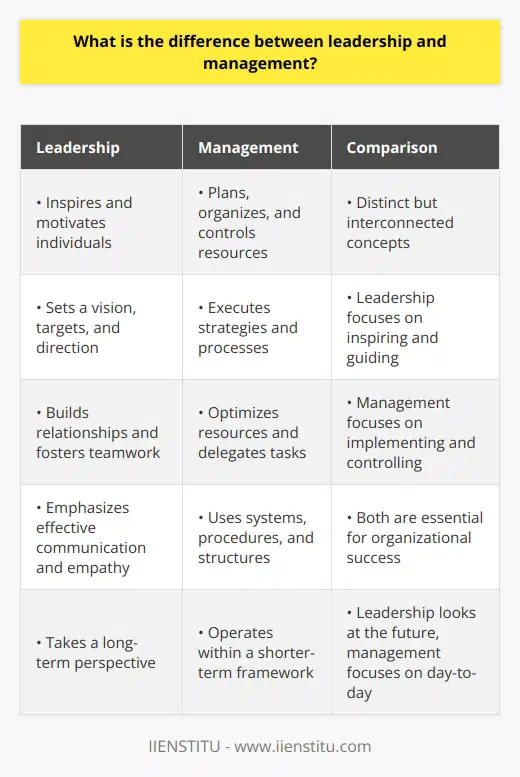
How do leading and managing roles differ in a business context?
In a business context, leading involves setting a strategic direction, fostering innovation, and motivating team members toward shared goals. On the other hand, managing is about overseeing the execution of strategies, coordinating tasks, and ensuring efficiency and productivity in daily operations.
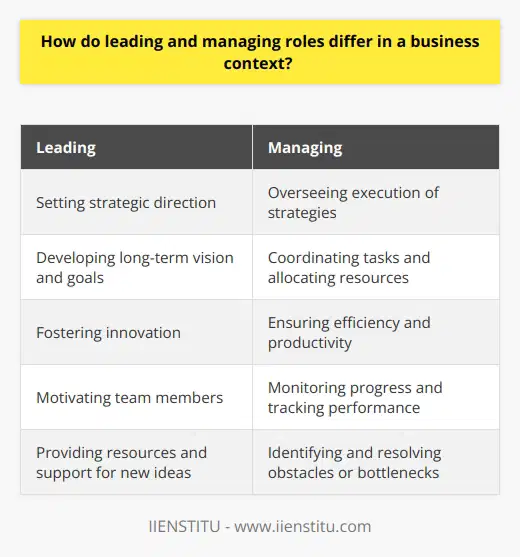
Can you describe the difference between transformational and transactional leaders?
Transformational leaders inspire their teams to exceed their interests and work towards the organization's greater good. They create a shared vision and foster an atmosphere of collaboration and innovation. In contrast, transactional leaders work within existing processes and systems, setting clear performance expectations and tying rewards or penalties to these expectations. They maintain order and consistency within the organization but might not necessarily foster creativity and personal growth.
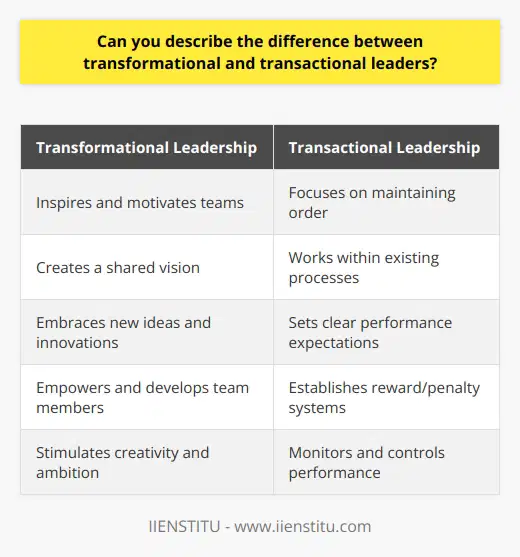
How does leading differ from managing in terms of people and processes?
Leading is primarily about inspiring, motivating, and influencing people. It involves stirring passion, fostering creativity, and guiding individuals toward a shared vision. On the other hand, managing revolves around controlling processes and coordinating tasks. It involves planning, organizing resources, and ensuring operations run efficiently to meet set goals.
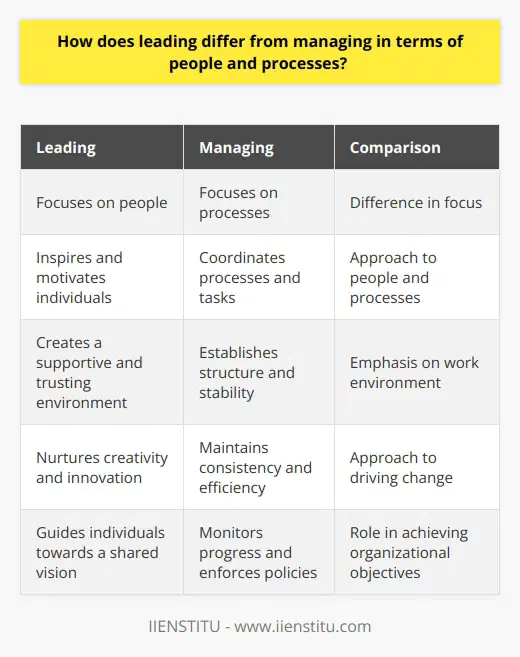
What does balancing leading vs. managing mean in an organization?
Balancing leading and managing in an organization means utilizing the strengths of both roles for optimal success. It involves setting a strategic direction and inspiring the team towards that vision (leading) while also overseeing the practical implementation of strategies, coordinating tasks, and ensuring resources are used efficiently (managing). This balancing act provides that the organization remains innovative and forward-thinking while staying productive and efficient in day-to-day operations.

What are the primary roles of a leader manager within an organization?
A leader manager embodies the characteristics of both roles. As a leader, they inspire, motivate, and guide the team toward a shared vision, igniting creativity and fostering a collaborative environment. As a manager, they organize and coordinate tasks, ensure efficiency in operations, monitor progress, and make necessary adjustments. Balancing both roles allows a leader manager to drive their organization towards success.
